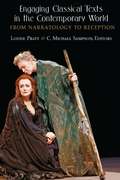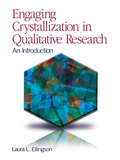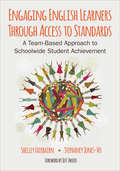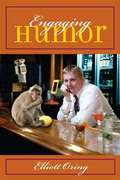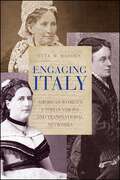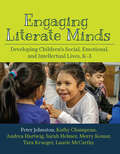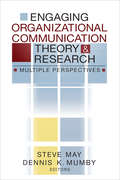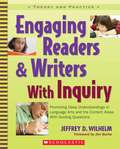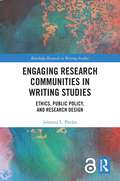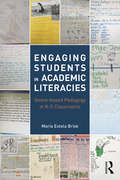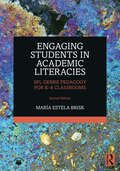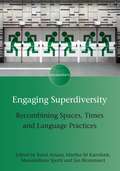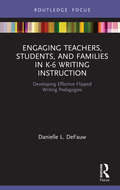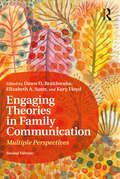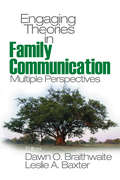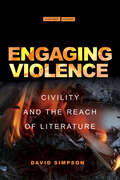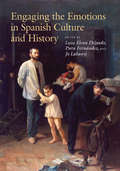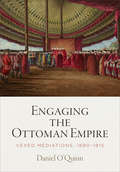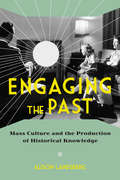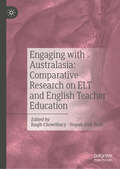- Table View
- List View
Engaging Classical Texts in the Contemporary World: From Narratology to Reception
by Louise H. Pratt C. M SampsonContemporary classicists often find themselves advocating for the value and relevance of Greco-Roman literature and culture, whether in the classroom, or social media, or newsprint and magazines. In this collection, twelve top scholars apply major critical approaches from other academic fields to open new channels for dialogue between ancient texts and the contemporary world. This volume considers perennial favorites of classical literature—the Iliad and Odyssey, Greek tragedy, Roman comedy, the Argonautica, and Ovid’s Metamorphoses—and their influence on popular entertainment from Shakespeare’s plays to Hollywood’s toga films. It also engages with unusual and intriguing texts across the centuries, including a curious group of epigrams by Artemidorus found on the island sanctuary of Thera, mysterious fragments of two Aeschylean tragedies, and modern-day North African novels. These essays engage an array of theoretical approaches from other fields—narratology, cognitive literary theory, feminist theory, New Historicist approaches to gender and sexuality, and politeness theory—without forsaking more traditional philological methods. A new look at hospitality in the Argonautica shows its roots in the changed historical circumstances of the Hellenistic world. The doubleness of Helen and her phantom in Euripides’ Helen is even more complex than previously noted. Particularly illuminating is the recurrent application of reception studies, yielding new takes on the ancient reception of Homer by Apollonius and of Aeschylus by Macrobius, the reception of Plautus by Shakespeare, and more contemporary examples from the worlds of cinema and literature. Students and scholars of classics will find much in these new interpretations and approaches to familiar texts that will expand their intellectual horizons. Specialists in other fields, particularly English, comparative literature, film studies, and gender and sexuality studies, will also find these essays directly relevant to their work.
Engaging Crystallization in Qualitative Research: An Introduction
by Laura L. EllingsonEngaging Crystallization in Qualitative Research, the first "how to" book to both explain and demonstrate crystallization methodology, offers a framework for blending grounded theory and other social scientific analyses with creative representations of data, such as narratives, poetry, and film. Author Laura L. Ellingson explores relevant epistemological questions that arise when crossing methodological boundaries, provides detailed steps for design and planning, offers guidelines for improving both social scientific and creative/artistic writing, and suggests strategies for targeting publication outlets for multigenre representations.
Engaging English Learners Through Access to Standards: A Team-Based Approach to Schoolwide Student Achievement
by Stephaney Jones-Vo Michele B. FairbairnUse this six-part strategy for measurable, cross-curricular EL achievement! How can districts and schools successfully promote academic English language development through teaching content knowledge and standards-based skills and abilities? This thoroughly researched book provides concrete answers. You’ll find practical steps and ideas for developing collaborative, cross-curricular programs that address EL-specific needs. Clear tables and templates, essays, expert research, and real-life teacher and parent stories illuminate best practices for appropriate standards-based instruction that gets results. Using the authors’ six-part ENGAGE Model, you’ll learn to: Establish a shared vision for serving ELs Name the expertise to utilize within collaborative teams Gather and analyze EL-specific data Align standards-based assessments and grading to ELs’ linguistic and content development Ground standards-based instruction in both content and language development Examine results to inform next steps Use this groundbreaking guide to accelerate progress and ensure effective instruction for all ELs! "Learning requires attention, engagement, and quality instruction. This book provides all three necessary components in one place; a model that teachers can use to ensure that their English learners achieve." -Douglas Fisher San Diego State University "This book should be a mandatory must read for all educators as we continue to serve our diverse student populations and strive to ensure we are honestly reaching academic achievement for each and every student!" -Michele R. Dean Coordinator,Ventura Unified School District
Engaging English Learners Through Access to Standards: A Team-Based Approach to Schoolwide Student Achievement
by Stephaney Jones-Vo Michele B. FairbairnUse this six-part strategy for measurable, cross-curricular EL achievement! How can districts and schools successfully promote academic English language development through teaching content knowledge and standards-based skills and abilities? This thoroughly researched book provides concrete answers. You’ll find practical steps and ideas for developing collaborative, cross-curricular programs that address EL-specific needs. Clear tables and templates, essays, expert research, and real-life teacher and parent stories illuminate best practices for appropriate standards-based instruction that gets results. Using the authors’ six-part ENGAGE Model, you’ll learn to: Establish a shared vision for serving ELs Name the expertise to utilize within collaborative teams Gather and analyze EL-specific data Align standards-based assessments and grading to ELs’ linguistic and content development Ground standards-based instruction in both content and language development Examine results to inform next steps Use this groundbreaking guide to accelerate progress and ensure effective instruction for all ELs! "Learning requires attention, engagement, and quality instruction. This book provides all three necessary components in one place; a model that teachers can use to ensure that their English learners achieve." -Douglas Fisher San Diego State University "This book should be a mandatory must read for all educators as we continue to serve our diverse student populations and strive to ensure we are honestly reaching academic achievement for each and every student!" -Michele R. Dean Coordinator,Ventura Unified School District
Engaging Humor
by Elliott OringElliott Oring asks essential questions concerning humorous expression in contemporary society, examining how humor works, why it is employed, and what its messages might be. This provocative book is filled with examples of jokes and riddles that reveal humor to be a meaningful--even significant--form of expression. Oring provides alternate ways of thinking about humorous expressions by examining their contexts--not just their contents. Engaging Humor demonstrates that when analyzed contextually and comparatively, humorous expressions emerge as communications that are startling, intriguing, and profound.
Engaging Italy: American Women's Utopian Visions and Transnational Networks
by Etta M. MaddenEngaging Italy charts the intertwined lives and writings of three American women in Italy in the 1860s and '70s—journalist Anne Hampton Brewster (1818–92), orphanage and industrial school founder Emily Bliss Gould (1825–75), and translator Caroline Crane Marsh (1816–1901). Brewster, Gould, and Marsh did not follow their callings abroad so much as they found them there. The political and religious unrest they encountered during Italian Unification put their utopian visions of expatriate life to the test. It also prompted these women to engage these changes and take up their pens both privately and publicly. Though little-known today, their diaries, letters, poetry, and news accounts help to rewrite the story of American women abroad inherited from figures such as Nathaniel Hawthorne, Mark Twain, and Henry James. Both feminist recovery project and collective biography, Engaging Italy contributes to the growing body of scholarship on transatlantic nineteenth-century women writers while focusing particular attention on the shared texts and ties linking Brewster, Gould, and Marsh. Etta M. Madden demonstrates the generative power of literary and social networks during moments of upheaval.
Engaging Literate Minds: Developing Children’s Social, Emotional, and Intellectual Lives, K–3
by Andrea Hartwig Peter Johnston Kathy Champeau Sarah HelmerIncreasingly, educators are recognizing that for children to thrive intellectually they need socially and emotionally healthy classrooms. Conveniently, this is exactly what parents have always wanted for their children's classrooms that offer and grow positive relationships and behavior, emotional self-regulation, and a sense of well-being. Using the guiding principles from Peter Johnston's best-selling professional resources, Choice Words and Opening Minds,Peter and six colleagues began a journey to create just such classrooms'senvironments in which children meaningfully engage with each other through reading, writing, making, and discussing books. Together, they bring you Engaging Literate Minds: Developing Children's Social, Emotional, and Intellectual Lives, K-3 where you'll discover how these teachers struggled and succeeded in building such classrooms. Inside you'll find the following: Practical ways to develop a caring learning community and children's socio-emotional competencePowerful teaching practices from real classroomsEngaging ways to encourage inquiry and student agencySuggestions on how to use formative assessment in everyday teaching practicesHelpful research behind the classroom practices and children's developmentWays to help students inspire and support each otherBuilding a just, caring, literate society has never been more important than it is today. By embracing the ideas and teaching strategies Engaging Literate Minds, you can help children to become socially, emotionally, and intellectually healthy. Not only do these classroom practices develop the skills to achieve district benchmarks and beyond, they help develop children's humanity.
Engaging Organizational Communication Theory and Research: Multiple Perspectives
by Steve May"This book offers a refreshing and engaging overview of the ways some research traditions in organizational communication have unfolded over time and continue to be connected to everyday, real events."—Patrice Buzzanell, Purdue University Engaging Organizational Communication Theory and Research: Multiple Perspectives is a book unlike any in the field. Each chapter is written by a prominent scholar who presents a theoretical perspective and discusses how he or she "engages" with it, personally examining what it means to study organizations. Rejecting the traditional model of a "reader," this volume demonstrates the intimate connections among theory, research, and personal experience. Significant theoretical perspectives such as post-positivism, social construction, rhetoric, critical theory, feminism, postmodernism, structuration theory, and globalization are discussed in terms of their history, assumptions, development, propositions, research, and applications. In addition to editors Steve May and Dennis K. Mumby, contributors include Brenda J. Allen, Karen Lee Ashcraft, George Cheney, Steven R. Corman, Stanley Deetz, Robert McPhee, Marshall Scott Poole, Cynthia Stohl, Bryan C. Taylor, and James R. Taylor. Key Features• An introduction that addresses the idea of engaged research.• Accessible and cutting edge accounts of important research traditions written by well-known leaders in the field.• Personal accounts of each scholar′s place in his or her field of study.• A conclusion that explores the future of organizational communication studies.• An extensive body of references on each perspective. Engaging Organizational Communication Theory and Research is an indispensable resource for anyone wishing to be familiar with current trends in the field of organizational communication. It is recommended as the main text for upper-level undergraduate and entry-level graduate courses in organizational communication theory. It is also an excellent supplementary text for related courses in departments of communication studies, business and management, sociology, and industrial relations.
Engaging Readers and Writers With Inquiry: Promoting Deep Understandings in Language Arts and the Content Areas With Guiding Questions
by Jeffrey D. WilhelmWhat makes a good relationship? How does flight influence behavior for humans and birds? Is it ever permissible to lie? Reframing our units and lessons with questions such as these makes learning more exciting for students. Wilhelm debunks the myth that teaching through inquiry is hard. He shares practical, easy ideas for turning state standards into engaging authentic questions that propel students toward deep understandings. Includes sample lessons, discussion techniques, and questioning schemes for all the content areas. For use with Grades 4 and up.
Engaging Research Communities in Writing Studies: Ethics, Public Policy, and Research Design (Routledge Research in Writing Studies)
by Johanna PhelpsThis book invites readers to reconsider how writing studies researchers work with Institutional Review Boards (IRBs) on behalf of their communities and argues that engaging with IRBs during the research design process helps practitioners conduct research more quickly and effectively. Using empirical data from both writing studies and extra-disciplinary contexts, Dr. Johanna Phelps presents findings from two discipline-wide studies, as well as metadata from two IRBs, to develop a principled engagement framework for writing studies researchers to interact with their communities. Phelps further examines the many facets of conducting research with human participants—from comprehending federal policy updates to pondering specific ethical issues to developing detailed research designs—and explores the confluence of ethics, policy, and methodology in a thoroughgoing philosophical investigation of writing studies as a public good. This engaging and timely exploration of research design will be an important resource for scholars and students of writing studies; rhetoric and composition; technical and professional communication; cultural rhetoric; literacy studies; research design; research methodologies; research ethics; IRBs; justice; and critical theory. Chapter 4 and Interchapter 4 of this book are freely available as a downloadable Open Access PDF under a Creative Commons Attribution-Non Commercial-No Derivatives 4.0 license https://www.taylorfrancis.com/books/engaging-research-communities-writing-studies-johanna-phelps/10.4324/9781003082002?context=ubx&refId=07fec855-89cc-48d3-b893-fbcd53272512. Chapter 6 and Interchapter 6 of this book are freely available as a downloadable Open Access PDF under a Creative Commons Attribution-Non Commercial-No Derivatives 4.0 license https://www.taylorfrancis.com/books/engaging-research-communities-writing-studies-johanna-phelps/10.4324/9781003082002?context=ubx&refId=07fec855-89cc-48d3-b893-fbcd53272512.
Engaging Students in Academic Literacies: Genre-Based Pedagogy for K-5 Classrooms
by María Estela BriskThe Common Core State Standards require schools to include writing in a variety of genres across the disciplines. Engaging Students in Academic Literacies provides specific information to plan and carry out genre-based writing instruction in English for K-5 students within various content areas. Informed by systemic functional linguistics—a theory of language IN USE in particular ways for particular audiences and social purposes—it guides teachers in developing students’ ability to construct texts using structural and linguistic features of the written language. This approach to teaching writing and academic language is effective in addressing the persistent achievement gap between ELLs and "mainstream" students, especially in the context of current reforms in the U.S. Transforming systemic functional linguistics and genre theory into concrete classroom tools for designing, implementing, and reflecting on instruction and providing essential scaffolding for teachers to build their own knowledge of its essential elements applied to teaching, the text includes strategies for apprenticing students to writing in all genres, features of elementary students’ writing, and examples of practice.
Engaging Students in Academic Literacies: SFL Genre Pedagogy for K-8 Classrooms
by María Estela BriskThe second edition of this important and practical text provides specific information to guide teachers in planning and carrying out genre writing instruction in English for K–8 students within the content areas. Informed by systemic functional linguistics (SFL)—a framework conducive to instruction that views language as a meaning-making resource—this book guides teachers by presenting concrete ways to teach writing in the language arts, science, and social science curricula. Introducing theory of language that is effective in addressing the writing development of all students, especially multilingual/multicultural groups, the book provides essential scaffolding for teachers to design and implement effective, inclusive curricula while building their own knowledge. Fully up to date, the second edition features new genres appropriate for middle school, examples of student writing, an expanded focus on genre pedagogy, a new chapter on bilingual learners, guidance for teaching in the middle grades, as well as clear steps to prepare genre units based two decades of experience working with whole schools. The chapter units cover distinct genres, including memoirs, historical, genres, fictional narratives, arguments, and more. With ready-to-use tools, the new edition prepares elementary and middle school teachers to meet and adapt to the variable demands of their own educational contexts. Easy to navigate, this teacher-friendly text is an essential resource for courses in academic writing, English education, and multilingual education, and for pre-service and practicing English Language Arts (ELA) teachers who want to expand their teaching abilities and knowledge bases.
Engaging Students in Critical Media Literacy: A Guidebook for Educators
by Yazid Basthomi Evynurul Laily Zen Rida AfrilyasantiThis edited book presents the integration of Critical Media Literacy (CML) principles into teaching English as a Foreign Language (EFL). This approach has its roots in content-based language learning, which aims to promote effective communication as the ultimate goal of language acquisition. This book highlights the profound influence of CML on educational methods, exploring the evolving concepts that support its integration and providing both theoretical perspectives and practical examples to illustrate its implementation. The book delineates methodologies for constructing and executing a CML integration framework in EFL lessons, offering various instructional strategies and reflective analyses and integrating the viewpoints of professionals, educators, and researchers. The book explores the complexities of CML, discussing the changing nature of language instruction in a world heavily influenced by media, and explores issues such as professional growth during educational restructuring, highlighting the significance of personal metamorphosis in attaining social equity. This book offers a concise yet thorough examination of CML integration in EFL settings, and it will be of interest to scholars specializing in education, media studies, and language instruction, as well as educators actively engaged in teaching, such as EFL teachers, curriculum developers, and educational policymakers.
Engaging Superdiversity: Recombining Spaces, Times and Language Practices
by Karel Arnaut Martha Sif KarrebækThis book is the fruition of five years' work in exploring the idea of superdiversity. The editors argue that sociolinguistic superdiversity could be a source of inspiration to a wide range of post-structuralist, post-colonial and neo-Marxist interdisciplinary research into the potential and the limits of human cultural creativity and societal renewal under conditions of increasing and complexifying global connectivity. Through case studies of language practices in spaces understood as inherently translocal and multi-layered (classrooms and schools, youth spaces, mercantile spaces and nation-states), this book explores the relevance of superdiversity for the social and human sciences and positions it as a research perspective in sociolinguistics and beyond.
Engaging Teachers, Students, and Families in K-6 Writing Instruction: Developing Effective Flipped Writing Pedagogies (Routledge Research in Literacy Education)
by Danielle L. DeFauwThis text draws on interviews, assignments, field notes, and observations from a flipped writing methodology course conducted with preservice elementary teachers in the US. In doing so, the text powerfully illustrates the benefits of using flipped methodologies in K-6 instruction to engage students, teachers, and families in authentic writing practices. Engaging Teachers, Students, and Families in K-6 Writing Instruction demonstrates the use of flipped writing methodologies to engage preservice teachers in literacy instruction, increase their confidence as writers, and bolster their understanding and application of pedagogical content knowledge. In turn, this underpins teachers’ ability to teach writing as an authentic, purpose-driven, audience-focused process. In particular, chapters explore effective teaching strategies including writing clinics, writing contests, and family literacy sessions which encourage writing development within a community of students, teachers, families, and authors. This text will be an engaging and informative guide for educational researchers, teacher educators, and preservice and inservice teachers looking to develop effective flipped writing pedagogies to support educators, students, and families.
Engaging Theories in Family Communication: Multiple Perspectives
by Dawn O. Braithwaite Kory Floyd Elizabeth A. SuterEngaging Theories in Family Communication, Second Edition delves deeply into the key theories in family communication, focusing on theories originating both within the communication discipline and in allied disciplines. Contributors write in their specific areas of expertise, resulting in an exceptional resource for scholars and students alike, who seek to understand theories spanning myriad topics, perspectives, and approaches. Designed for advanced undergraduate and graduate students studying family communication, this text is also relevant for scholars and students of personal relationships, interpersonal communication, and family studies. This second edition includes 16 new theories and an updated study of the state of family communication. Each chapter follows a common pattern for easy comparison between theories.
Engaging Theories in Family Communication: Multiple Perspectives
by Dawn O. BraithwaiteEngaging Theories in Family Communication: Multiple Perspectives covers uncharted territory in its field, as it is the first book on the market to deal exclusively with family communication theory. In this volume, editors Dawn O. Braithwaite and Leslie A. Baxter bring together a group of contributors that represent a veritable Who's Who in the family communication field. These scholars examine both classic and cutting-edge theories to guide family communication research in the coming years.
Engaging Theories in Interpersonal Communication: Multiple Perspectives
by Dawn O. Braithwaite Paul SchrodtWinner of the 2017 NCA Gerald R. Miller Book Award! Use and Understand Interpersonal Communication Theories Engaging Theories in Interpersonal Communication: Multiple Perspectives highlights key theories used to guide interpersonal communication research. The Second Edition features 30 theory chapters written by leading scholars in interpersonal communication, including new coverage of evolutionary theories, Problematic Integration Theory, supportive communication theories, Theory of Motivated Information Management, critical approaches to interpersonal communication, and Media Multiplexity Theory. Each theory chapter follows the same structure to help readers easily find and compare information across theories. An updated introductory chapter maps the history and the current state of interpersonal communication theory since publication of the first edition, based on comprehensive analysis of published scholarship. Presenting both classic and cutting-edge issues, the book organizes theories into three clusters—theories that are individually-centered; theories that are focused on discourse and interaction processes; and theories that examine how communication functions in personal relationships. All authors interweave abstract theoretical concepts with concrete examples in order to maximize readability and comprehension.
Engaging Theories in Interpersonal Communication: Multiple Perspectives
by Dawn O. Braithwaite Paul SchrodtWinner of the 2017 NCA Gerald R. Miller Book Award! Use and Understand Interpersonal Communication Theories Engaging Theories in Interpersonal Communication: Multiple Perspectives highlights key theories used to guide interpersonal communication research. The Second Edition features 30 theory chapters written by leading scholars in interpersonal communication, including new coverage of evolutionary theories, Problematic Integration Theory, supportive communication theories, Theory of Motivated Information Management, critical approaches to interpersonal communication, and Media Multiplexity Theory. Each theory chapter follows the same structure to help readers easily find and compare information across theories. An updated introductory chapter maps the history and the current state of interpersonal communication theory since publication of the first edition, based on comprehensive analysis of published scholarship. Presenting both classic and cutting-edge issues, the book organizes theories into three clusters—theories that are individually-centered; theories that are focused on discourse and interaction processes; and theories that examine how communication functions in personal relationships. All authors interweave abstract theoretical concepts with concrete examples in order to maximize readability and comprehension.
Engaging Violence: Civility and the Reach of Literature (Cultural Memory in the Present)
by David SimpsonRecent thinking has resuscitated civility as an important paradigm for engaging with a violence that must be deemed endemic to our lives. But, while it is widely acknowledged that civility works against violence, and that literature generates or accompanies civility and engenders tolerance, civility has also been understood as violence in disguise, and literature, which has only rarely sought to claim the power of violence, has often been accused of inciting it. This book sets out to describe the ways in which these words—violence, literature and civility—and the concepts they evoke are mutually entangled, and the uses to which these entanglements have been put. Simpson's argument follows a broadly historical trajectory through the long modern period from the Renaissance to the present, drawing on the work of historians, political scientists, literary scholars and philosophers. The result is a distinctly new argument about the complex and often mystified entanglements between literature, civility and violence in the anglophone Atlantic sphere. What now are our expectations of civility and literature, separately and together? How do these long-familiar but residually imprecise concepts stand up to the demands of the modern world? Simpson's argument is that, despite and perhaps because of their imperfect conceptualization, both persist as important protocols for the critique of violence.
Engaging the Emotions in Spanish Culture and History
by Jo Labanyi Luisa Elena Delgado Pura FernandezRather than being properties of the individual self, emotions are socially produced and deployed in specific cultural contexts, as this collection documents with unusual richness. All the essays show emotions to be a form of thought and knowledge, and a major component of social life—including in the nineteenth century, which attempted to relegate them to a feminine intimate sphere.The collection ranges across topics such as eighteenth-century sensibility, nineteenth-century concerns with the transmission of emotions, early twentieth-century cinematic affect, and the contemporary mobilization of political emotions including those regarding nonstate national identities. The complexities and effects of emotions are explored in a variety of forms—political rhetoric, literature, personal letters, medical writing, cinema, graphic art, soap opera, journalism, popular music, digital media—with attention paid to broader European and transatlantic implications.
Engaging the Emotions in Spanish Culture and History
by Luisa Elena Delgado, Pura Fernández, and Jo LabanyiRather than being properties of the individual self, emotions are socially produced and deployed in specific cultural contexts, as this collection documents with unusual richness. All the essays show emotions to be a form of thought and knowledge, and a major component of social life—including in the nineteenth century, which attempted to relegate them to a feminine intimate sphere. The collection ranges across topics such as eighteenth-century sensibility, nineteenth-century concerns with the transmission of emotions, early twentieth-century cinematic affect, and the contemporary mobilization of political emotions including those regarding nonstate national identities. The complexities and effects of emotions are explored in a variety of forms—political rhetoric, literature, personal letters, medical writing, cinema, graphic art, soap opera, journalism, popular music, digital media—with attention paid to broader European and transatlantic implications.
Engaging the Ottoman Empire: Vexed Mediations, 1690-1815 (Material Texts)
by Daniel O'QuinnDaniel O'Quinn investigates the complex interpersonal, political, and aesthetic relationships between Europeans and Ottomans in the long eighteenth century. Bookmarking his analysis with the conflict leading to the 1699 Treaty of Karlowitz on one end and the 1815 bid for Greek independence on the other, he follows the fortunes of notable British, Dutch, and French diplomats to the Sublime Porte of the Ottoman Empire as they lived and worked according to the capitulations surrendered to the Sultan.Closely reading a mixed archive of drawings, maps, letters, dispatches, memoirs, travel narratives, engraved books, paintings, poems, and architecture, O'Quinn demonstrates the extent to which the Ottoman state was not only the subject of historical curiosity in Europe but also a key foil against which Western theories of governance were articulated. Juxtaposing narrative accounts of diplomatic life in Constantinople, such as those contained in the letters of Lady Mary Wortley Montagu, wife of the English ambassador, with visual depictions such as those of the costumes of the Ottoman elite produced by the French-Flemish painter Jean Baptiste Vanmour, he traces the dissemination of European representations and interpretations of the Ottoman Empire throughout eighteenth-century material culture.In a series of eight interlocking chapters, O'Quinn presents sustained and detailed case studies of particular objects, personalities, and historical contexts, framing intercultural encounters between East and West through a set of key concerns: translation, mediation, sociability, and hospitality. Richly illustrated and provocatively argued, Engaging the Ottoman Empire demonstrates that study of the Ottoman world is vital to understanding European modernity.
Engaging the Past: Mass Culture and the Production of Historical Knowledge
by Alison LandsbergReading films, television dramas, reality shows, and virtual exhibits, among other popular texts, Engaging the Past examines the making and meaning of history for everyday viewers. Contemporary media can encourage complex interactions with the past that have far-reaching consequences for history and politics. Viewers experience these representations personally, cognitively, and bodily, but, as this book reveals, not just by identifying with the characters portrayed. Some of the works considered in this volume include the films Hotel Rwanda (2004), Good Night and Good Luck (2005), and Milk (2008); the television dramas Deadwood, Mad Men, and Rome; the reality shows Frontier House, Colonial House, and Texas Ranch House; and The Secret Annex Online, accessed through the Anne Frank House website, and the Kristallnacht exhibit, accessed through the Unites States Holocaust Museum website. These mass cultural texts cultivate what Alison Landsberg calls an "affective engagement" with the past, tying the viewer to an event or person and fostering a sense of intimacy that does more than transport the viewer back in time. Affect, she suggests, can also work to disorient the viewer, forcibly pushing him or her out of the narrative and back into his or her own body. By analyzing these specific popular history formats, Landsberg shows the unique way they provoke historical thinking and produce historical knowledge, prompting a reconsideration of what constitutes history and an understanding of how history works in the contemporary mediated public sphere.
Engaging with Australasia: Comparative Research on ELT and English Teacher Education
by Raqib Chowdhury Huynh Anh TuanThe book showcases collaborative intercultural research into English language teaching and English language teacher education across Australasia covering a broad range of topics from English education policies, curricular reform and practices, teacher professional development, and teacher and student identities. Together, the selected studies showcase how, in the shadow of the Pandemic, newer configurations in developing Asian and South-East Asian countries have complicated collaboration in teaching and research and how these contrast with practices in Australia. In particular, the studies highlight the need for both cultural and pedagogical adaptations in practitioners’ engagement with both policy and pedagogy. The book finds interested readership among emerging educators including graduate and doctoral researchers, as well as educators and policymakers.
